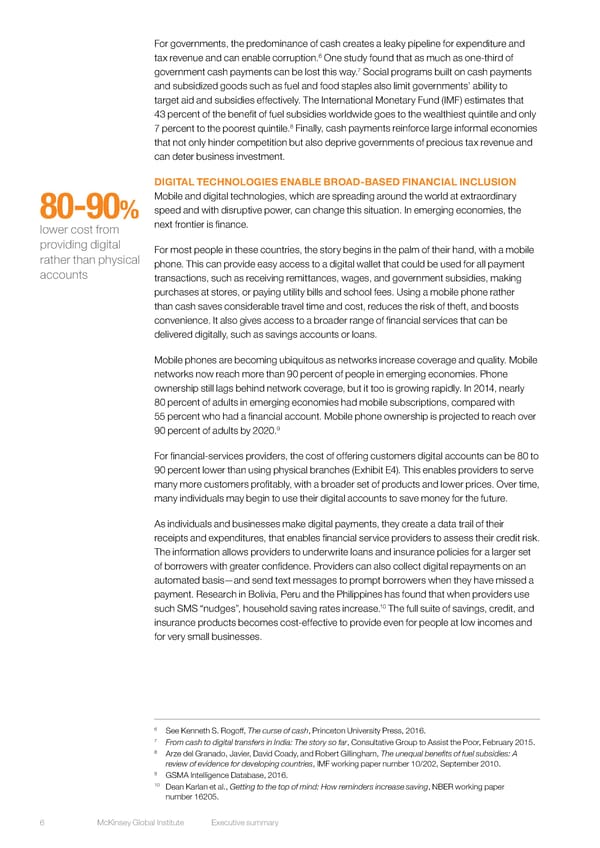For governments, the predominance of cash creates a leaky pipeline for expenditure and 6 tax revenue and can enable corruption. One study found that as much as one-third of 7 government cash payments can be lost this way. Social programs built on cash payments and subsidized goods such as fuel and food staples also limit governments’ ability to target aid and subsidies effectively. The International Monetary Fund (IMF) estimates that 43 percent of the benefit of fuel subsidies worldwide goes to the wealthiest quintile and only 8 7 percent to the poorest quintile. Finally, cash payments reinforce large informal economies that not only hinder competition but also deprive governments of precious tax revenue and can deter business investment. DIGITAL TECHNOLOGIES ENABLE BROAD-BASED FINANCIAL INCLUSION Mobile and digital technologies, which are spreading around the world at extraordinary 80-90% speed and with disruptive power, can change this situation. In emerging economies, the lower cost from next frontier is finance. providing digital For most people in these countries, the story begins in the palm of their hand, with a mobile rather than physical phone. This can provide easy access to a digital wallet that could be used for all payment accounts transactions, such as receiving remittances, wages, and government subsidies, making purchases at stores, or paying utility bills and school fees. Using a mobile phone rather than cash saves considerable travel time and cost, reduces the risk of theft, and boosts convenience. It also gives access to a broader range of financial services that can be delivered digitally, such as savings accounts or loans. Mobile phones are becoming ubiquitous as networks increase coverage and quality. Mobile networks now reach more than 90 percent of people in emerging economies. Phone ownership still lags behind network coverage, but it too is growing rapidly. In 2014, nearly 80 percent of adults in emerging economies had mobile subscriptions, compared with 55 percent who had a financial account. Mobile phone ownership is projected to reach over 9 90 percent of adults by 2020. For financial-services providers, the cost of offering customers digital accounts can be 80 to 90 percent lower than using physical branches (Exhibit E4). This enables providers to serve many more customers profitably, with a broader set of products and lower prices. Over time, many individuals may begin to use their digital accounts to save money for the future. As individuals and businesses make digital payments, they create a data trail of their receipts and expenditures, that enables financial service providers to assess their credit risk. The information allows providers to underwrite loans and insurance policies for a larger set of borrowers with greater confidence. Providers can also collect digital repayments on an automated basis—and send text messages to prompt borrowers when they have missed a payment. Research in Bolivia, Peru and the Philippines has found that when providers use 10 The full suite of savings, credit, and such SMS “nudges”, household saving rates increase. insurance products becomes cost-effective to provide even for people at low incomes and for very small businesses. 6 See Kenneth S. Rogoff, The curse of cash, Princeton University Press, 2016. 7 From cash to digital transfers in India: The story so far, Consultative Group to Assist the Poor, February 2015. 8 Arze del Granado, Javier, David Coady, and Robert Gillingham, The unequal benefits of fuel subsidies: A review of evidence for developing countries, IMF working paper number 10/202, September 2010. 9 GSMA Intelligence Database, 2016. 10 Dean Karlan et al., Getting to the top of mind: How reminders increase saving, NBER working paper number 16205. 6 McKinsey Global Institute Executive summary
 EXECUTIVE SUMMARY Page 5 Page 7
EXECUTIVE SUMMARY Page 5 Page 7